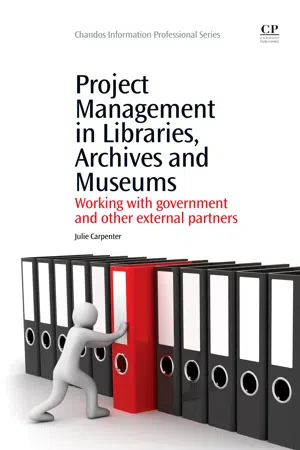
Project Management in Libraries, Archives and Museums
Working with Government and Other External Partners
- 226 pages
- English
- ePUB (mobile friendly)
- Available on iOS & Android
Project Management in Libraries, Archives and Museums
Working with Government and Other External Partners
About this book
Aimed at practitioners and managers, this practical handbook provides a source of guidance on project management techniques for the academic and cultural heritage sectors, focusing on managing projects involving public sector and other external partners. Issues under consideration and illustration include: different approaches to managing projects and how to select appropriate methods; using project management tools and other applications in project development and implementation; ensuring the sustainability of project outcomes and transferability into practice; realistic monitoring methodologies and specification and commissioning evaluation work that has real value.- Written by an experienced project manager, it addresses project management realities rather than theory- Deconstructs the traditional 'project cycle' model to address different project approaches- Takes into account the government and local government context, especially operational procedures and accountability
Frequently asked questions
- Essential is ideal for learners and professionals who enjoy exploring a wide range of subjects. Access the Essential Library with 800,000+ trusted titles and best-sellers across business, personal growth, and the humanities. Includes unlimited reading time and Standard Read Aloud voice.
- Complete: Perfect for advanced learners and researchers needing full, unrestricted access. Unlock 1.4M+ books across hundreds of subjects, including academic and specialized titles. The Complete Plan also includes advanced features like Premium Read Aloud and Research Assistant.
Please note we cannot support devices running on iOS 13 and Android 7 or earlier. Learn more about using the app.
Information
What does project management mean?
Introduction
What is a project?



Kinds of projects



| Characteristics | Relatively simple projects | Complex projects |
| e.g. moving office, creating a new website, or organising a conference | e.g. national digitisation project, merging two archives, implementing a new institutional repository | |
| People | Involvement of a small group of people who are all working in the same building and organisation | Involvement of people from different professional backgrounds, different teams and organisations. Involvement of people with a range of first languages, from different cultures, or living in different time zones. Involvement of a large number of different activities involving a number of different people |
| Data | Relatively low volumes of data | Involves large volumes of data |
| Risks | Risks can be easily identified | Hard to identify all the risks |
| Innovation | Low levels of innovation; while the project may be novel to the project team there is existing good practice in this type of work | High levels of innovation |
| Technology | Working with relatively well-established and tested technology | Working in a technical environment that is changing at a rapid pace; working with technologies that are new to the local environment and not well-supported |
| Working methods | Use of tried and tested methods (even if they are new to the project team) | Working procedures are established by an external body which may change them throughout the project |
| Management | Project manager has complete control over the project | External body or another person may have real power e.g. over timescale, resources, people. Responsibility for the project may be shared e.g. by managers working in different orga... |
Table of contents
- Cover image
- Title page
- Table of Contents
- Copyright
- List of figures and tables
- Acknowledgements
- List of abbreviations and acronyms
- About the author
- Chapter 1: What does project management mean?
- Chapter 2: Project planning and review
- Chapter 3: Working in project partnerships
- Chapter 4: Risk management
- Chapter 5: Managing human resources within a project
- Chapter 6: Managing other project resources
- Chapter 7: Evaluation and review
- Chapter 8: Quality management in projects
- Chapter 9: Sustainability of projects
- Chapter 10: Using information and communication technology in project management
- Useful resources
- Glossary of project management terms
- Index